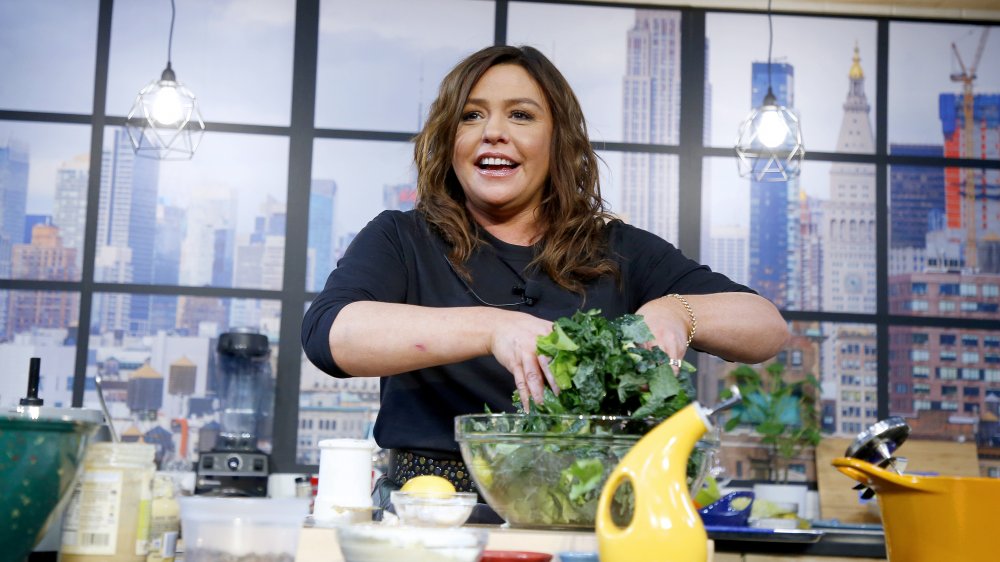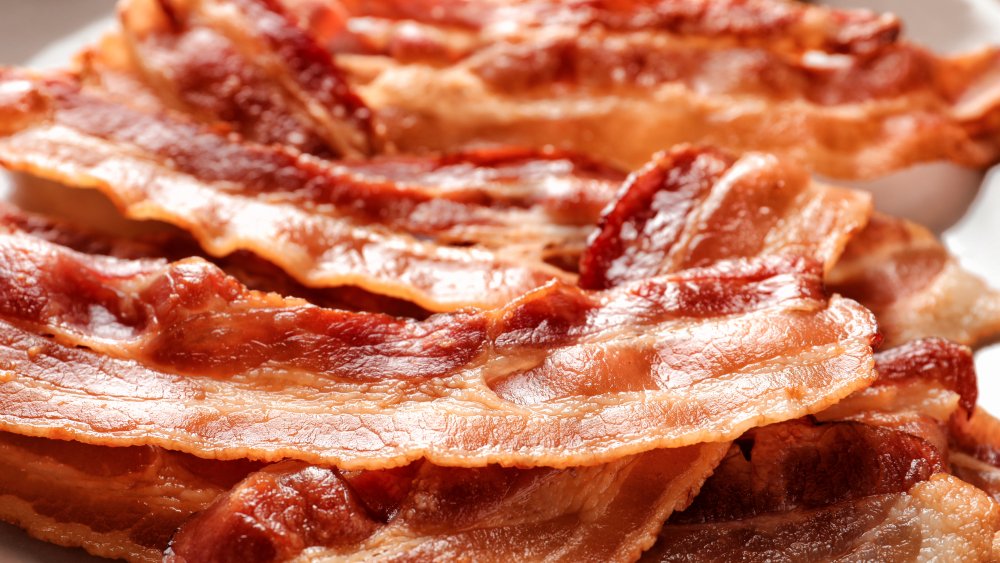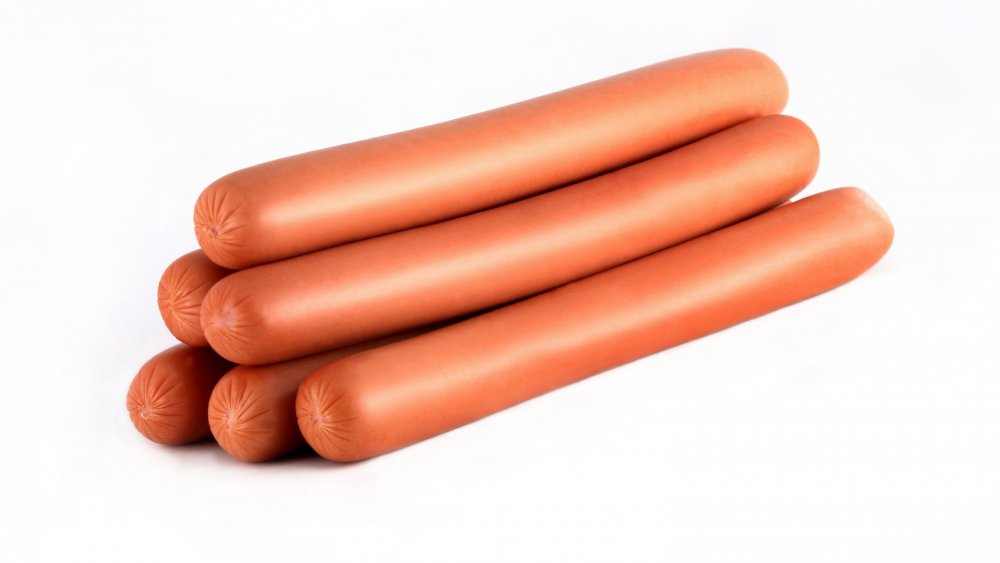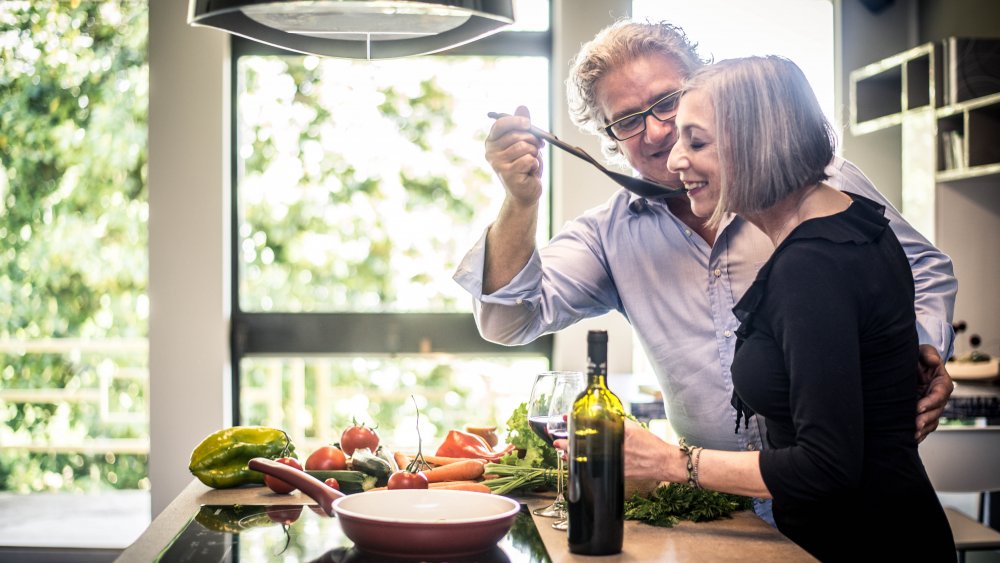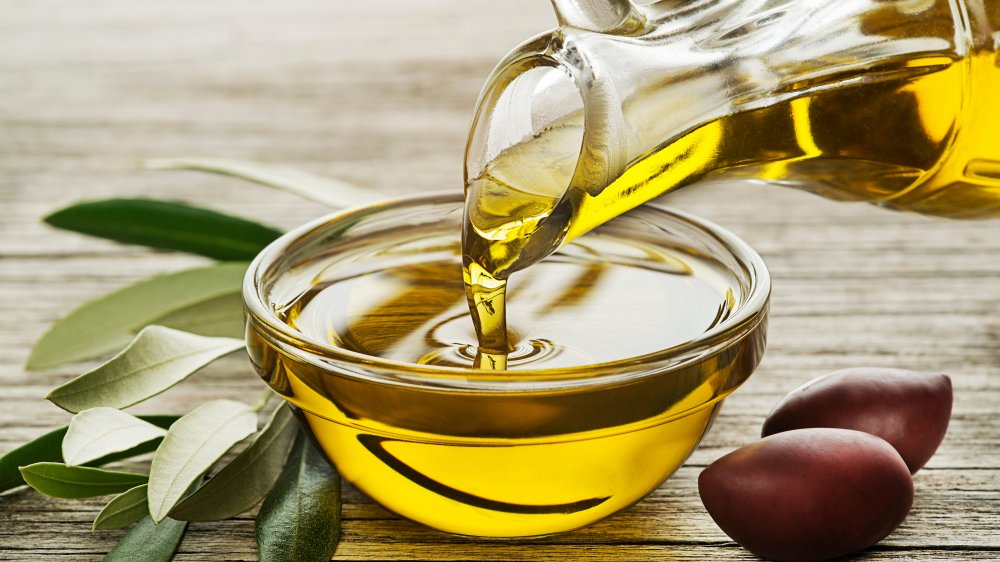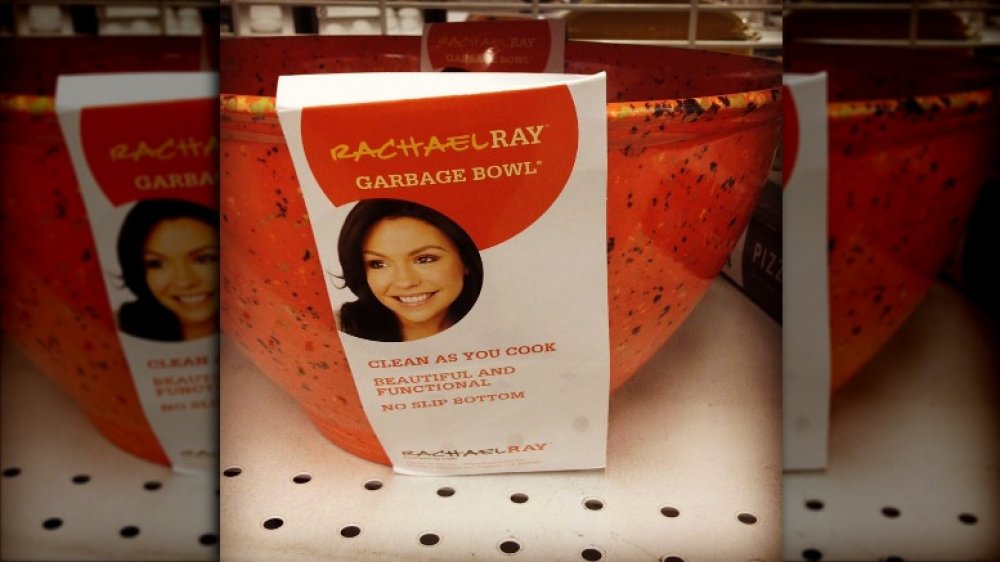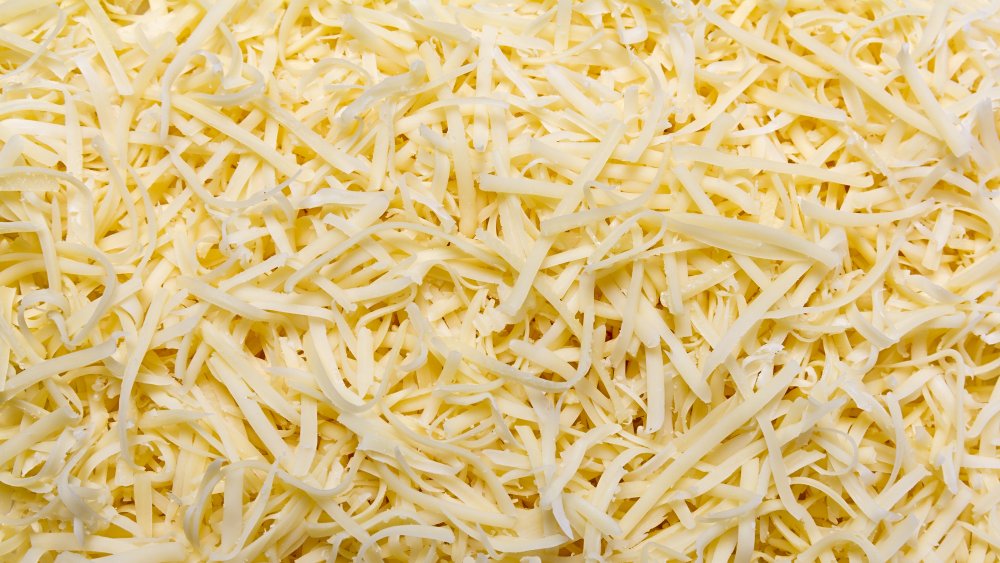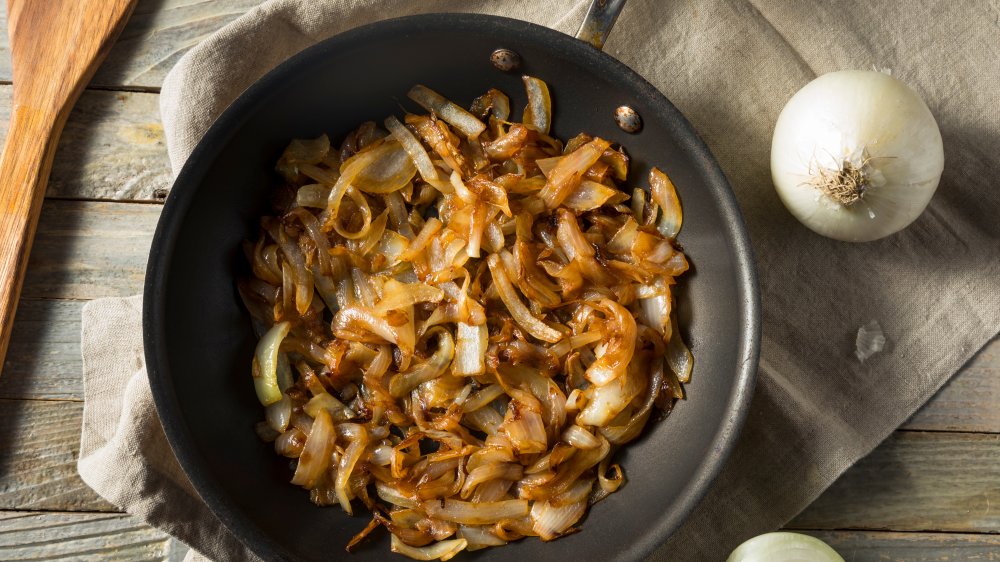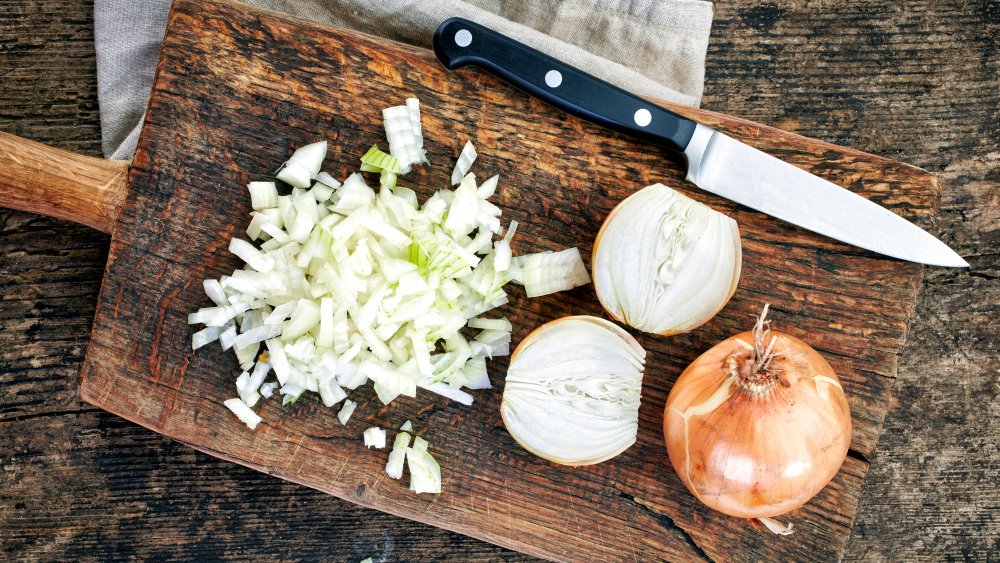Lies Rachael Ray Made You Believe About Cooking
Rachael Ray rose from a small-town girl leading cooking classes in New York supermarkets to a Food Network star and multi-hyphenate media mogul. She's published over a dozen cookbooks, won a Daytime Emmy, and founded the magazine Every Day with Rachael Ray, now known as Rachael Ray In Season. Her first Food Network show, 30 Minute Meals started out as a weekly show on a local news station in Albany, and since then, Ray has hosted $40 A Day, Inside Dish, and Rachel Ray's Tasty Travels and even hosted her own nationally syndicated talk show, The Rachael Ray Show.
Rachael Ray has no formal culinary training and says that she is "a cook, not a chef." Her lack of cooking school credentials and her bubbly personality have made her a target of many other celebrity chefs, such as Anthony Bourdain, Martha Stewart, and Emeril Lagasse. Whether you love her or hate her, Rachael Ray has had an undeniable impact on American food culture by making easy, accessible dishes the core of her brand. But despite all her accomplishments, Rachael Ray has led her fans astray more than once. Check out some of the lies she's told her fans in the past.
Rachael Ray said you need a recipe to microwave bacon
We know that Rachael Ray's brand isn't exactly haute cuisine, but her recipe for "Late Night Bacon" goes where no cookbook ever needs to go: to the instructions that are printed on the back of every package of bacon sold in a supermarket. The recipe begins with: "You don't need a skillet to fry up some bacon. Follow Rachael's easy instructions to sizzle it in the microwave instead." Come on, Food Network. Give your viewers a little credit. This reminds us of the all-time best non-recipe, a recipe for making ice cubes, except Rachael Ray's unnecessary recipe is not a satire.
Late Night Bacon, aka just some bacon you put on a paper towel and throw in the microwave, isn't the only non-recipe from Rachael Ray. See her "Spicy Breakfast Sammie Baked Potato," a recipe that is not only annoying for its cloying use of "sammie" instead of "sandwich" but also that it's just a basic breakfast sandwich that replaces the bun with a potato. We're pretty sure literally anyone could figure that out without Rachael Ray's guidance.
Rachael Ray claimed you can put diced hot dogs in pretty much anything
We're not above a diced hot dog. Jollibee's Jolly Spaghetti is a surprising fast-food gem, and many of us grew up with the New England classic known as "beanie-weenies." But it's safe to say that Rachael Ray takes the diced hot dog past the point of reasonable. Let's take a look at her Chili Dog Bacon Cheeseburgers recipe, in which she mixes diced hot dogs into hamburger patties. If you've ever made hamburgers, you know that concocting a hamburger patty that cooks well, doesn't fall apart, and tastes good is a tricky balance to strike. Mixing in big chunks of diced hot dogs is a great way to get a hamburger that will fall apart and/or not cook evenly.
But wait, there are more diced hot dog lies in the Rachael Ray canon. Her Mac and Cheese Dog Casserole mixes beer, mustard, ketchup, and diced hot dogs into a mac and cheese casserole. What did a mac and cheese casserole do to deserve this? Furthermore, Rachael Ray's Chicago Dog Salad is a crime against salad. Cooked hot dogs are greasy and delicious, but cooked, greasy hot dogs in a salad leaves you with a greasy salad. No thanks, Rachael Ray!
Rachael Ray's lie that you can make rice with wine instead of water
In theory, rice made with wine sounds nice, like when you use chicken broth instead of water to make rice pilaf. In practice, anyone who's ever been a little too heavy-handed with the wine while making a risotto knows this is a capital "B" bad idea. Too much wine in any dish is going to overpower any other flavor and leave only the taste of warm, sour wine. Rachael Ray's "Red Wine Rice with Grapes" recipe is a culinary disaster waiting to happen, and it's a total lie that it tastes good. Don't take our word for it. Blogger Cate O'Malley described this recipe as "inedible," saying, "It was like pouring yourself a glass of wine and adding some bits of cooked rice to your glass." Gross. We're also skeptical of the inclusion of grapes in this recipe, as we don't think anyone has ever thought, "You know what's delicious? Warm grapes."
For a reasonable recipe that uses red wine to add flavor to rice, try this Red Wine Rice recipe from Food52. Note that this recipe uses four cups of chicken stock and only half a cup of red wine.
Rachael Ray's EVOO might be a lie ... and less than EV (extra virgin)
Rachael Ray loves to shorten or jazz up common culinary terms. Some people think it's endearing. Some people think it's annoying. For a while, Rachael Ray was, much like Gretchen from Mean Girls, trying to make "fetch" happen, attempting to make "EVOO" a part of the cooking lexicon. Extra virgin olive oil, a cooking staple that had existed for thousands of years, suddenly needed a nickname. She even came out with her own brand of extra virgin olive oil that, of course, was labeled EVOO.
What's the difference between extra virgin olive oil and regular olive oil? According to the Masterclass Complete Guide to Olive Oil, extra virgin olive oil is made by pressing and grinding olives without any chemicals, heat, or other processes. Light olive oil — named for the color — is a refined oil, meaning that in addition to the processes of pressing and grinding olives, there is also an application of heat.
But it turns out that Rachael Ray's "EVOO" was most likely just "OO" minus the "EV." According to a study by the UC Davis Olive Center at the university's Robert Mondavi Institue for Wine and Food Science, more than two-thirds of random samples of imported extra virgin olive oil tested were shown to be diluted, adulterated, or otherwise fail to meet the standard of "extra virgin." Did Rachael lie to us?
Rachael Ray's lie that you need a special garbage bowl instead of a trash can
Along the lines of "EVOO," "sammies," and "delish" comes another Rachael-ism (and another Rachael lie): the garbage bowl, a large bowl used to collect scraps, odd ends, and other waste to save a home cook from running back and forth to a trash can. In theory, we have no problem with this. We've all used bowls to collect bits and pieces while cooking. That having been said, Rachael Ray's garbage bowls are enormous. The idea of just piling up scraps in a huge bowl and not taking it to the trash at any point strikes us as pretty gross. How much time does it really save you? How big is your kitchen that running over the trash can to dump vegetable scraps off of a cutting board is an onerous time suck?
But regardless of whether you're a clean-as-you-go, organized home cook or have a slightly more chaotic style, we can all agree that Rachael Ray marketing a large ceramic bowl as a "garbage bowl" is the end phenomenon of celebrity chef cookware lines. Large bowls have always existed. Just like the Late-Night Bacon recipe, it makes you wonder: Why is this a thing?
Rachael Ray said you can mix fish and cheese with abandon
We're not saying you can never mix fish and cheese. Lox on a bagel with cream cheese and lobster mac and cheese are classic dishes for a reason. But Italians do not take mixing fish and cheese lightly, and this is why Rachael Ray's "Antip-acho Italian Nachos and Fish Stick Parm" is an unholy mess of ingredients. Cookbook author and Italian food expert Julia della Croce said in an interview, "Italians are very religious about mixing cheese and fish or seafood, it just isn't done" (via Atlas Obscura).
Antipasto means "before the meal," and it usually consists of cured meat, cheese, and olives. Nachos are a big plate of corn chips with cheese, meat, and pico de gallo. Both are awesome, but why the fusion? Why two and a half cups of shredded cheese on top of fish sticks, Rachael Ray? If you want to smother frozen fish sticks with cheese, fine, but please don't call it antipasto or "antip-acho." It's a flat-out lie that many Italians out there would stand for this.
Rachael Ray's recipes lie about how long it takes to caramelize onions
Rachael Ray, queen of quick dinners, is all about efficiency in the kitchen, and accessible, easy weeknight dinners are her brand. Making caramelized onions properly does not fit into a quick, easy dinner, but if you let onions simmer for fifteen to twenty minutes and call them "caramelized," then we guess it can. In Rachael Ray's defense, she is not the only cookbook author to fudge the amount of time it takes to truly, properly caramelize onions. Slate writer Tom Scocca wrote in a fantastic piece entitled Layers of Deceit: Why do recipe writers lie and lie and lie about how long it takes to caramelize onions?: "Telling the truth about caramelized onions would turn a lot of dinner-in-half-an-hour recipes into dinner-in-a-little-over-an-hour recipes." Truly caramelized onions take at least 45 minutes. If you don't believe me, you're probably eating sautéed onions and calling them caramelized.
Rachael Ray's underestimation is a little less galling than some other recipe writers'. Her recipes for Caramelized Onion Penne and Bacon Burgers with Caramelized Onions and Gorgonzola both claim that the onions should be done in 20 to 30 minutes as opposed to the truly baffling 10 minutes seen in other recipes. Regardless of how wrong Rachael Ray is, though, she is wrong. It takes longer than 20 minutes to caramelize onions. If you want to save time, make caramelized onions ahead of time and store in an airtight container in the refrigerator.
Rachael Ray said that buying pre-cut veggies is totally cool
We totally get the urge to buy pre-cut vegetables. They seem like a great way to save time in the kitchen. Unfortunately, they lead to unnecessary packaging and waste. A bell pepper, un-chopped, is its own container. Chop it up, and now you need styrofoam and plastic wrap. Moreover, sliced vegetables and fruit spoil faster and are generally not as fresh. Onions can make chefs cry, but if you buy pre-sliced onions, you're sacrificing moisture and flavor to avoid a minute of inconvenience. It's just not that hard to chop up an onion, a head of cauliflower, or any vegetable that isn't a super hearty squash. (And even squash isn't that bad if you have a good knife.) Pre-cut vegetables are also much more expensive than whole produce.
Rachael Ray, the efficiency and convenience queen, included pre-cut vegetables on a list of otherwise very good kitchen short cuts, saying, "I often suggest pre-shredded cheese and pre-cut veggies as options in my recipes. They offer convenience that's hard to beat." Shredding a ball of mozzarella does take quite a while, but the downsides of buying packaged, pre-cut vegetables for the planet, your wallet, and your taste buds outweigh the very small amount of time they might save you in the kitchen. It's simply a lie that you can't manage to chop your veggies yourself.
